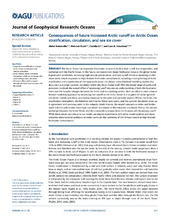| dc.contributor.author | Nummelin, Aleksi | |
| dc.contributor.author | Ilicak, Mehmet | |
| dc.contributor.author | Li, Camille | |
| dc.contributor.author | Smedsrud, Lars Henrik | |
| dc.date.accessioned | 2016-11-03T10:33:12Z | |
| dc.date.available | 2016-11-03T10:33:12Z | |
| dc.date.issued | 2016-01-21 | |
| dc.identifier.issn | 2169-9275 | en_US |
| dc.identifier.uri | https://hdl.handle.net/1956/13049 | |
| dc.description.abstract | The Arctic Ocean has important freshwater sources including river runoff, low evaporation, and exchange with the Pacific Ocean. In the future, we expect even larger freshwater input as the global hydrological cycle accelerates, increasing high-latitude precipitation, and river runoff. Previous modeling studies show some robust responses to high-latitude freshwater perturbations, including a strengthening of Arctic stratification and a weakening of the large-scale ocean circulation; some idealized modeling studies also document a stronger cyclonic circulation within the Arctic Ocean itself. With the broad range of scales and processes involved, the overall effect of increasing runoff requires an understanding of both the local processes and the broader linkages between the Arctic and surrounding oceans. Here we adopt a more comprehensive modeling approach by increasing river runoff to the Arctic Ocean in a coupled ice-ocean general circulation model, and show contrasting responses in the polar and subpolar regions. Within the Arctic, the stratification strengthens, the halocline and Atlantic Water layer warm, and the cyclonic circulation spins up, in agreement with previous work. In the subpolar North Atlantic, the model simulates a colder and fresher water column with weaker barotropic circulation. In contrast to the estuarine circulation theory, the volume exchange between the Arctic Ocean and the surrounding oceans does not increase with increasing runoff. While these results are robust in our model, we require experiments with other model systems and more complete observational syntheses to better constrain the sensitivity of the climate system to high-latitude freshwater perturbations. | en_US |
| dc.language.iso | eng | eng |
| dc.publisher | Wiley | en_US |
| dc.publisher | American Geophysical Union (AGU) | en_US |
| dc.relation.ispartof | <a href="http://hdl.handle.net/1956/13050" target="blank">The Arctic Ocean in a Fresh and Warm Future</a> | en_US |
| dc.rights | Attribution-NonCommercial-NoDerivs CC BY-NC-ND | eng |
| dc.rights.uri | http://creativecommons.org/licenses/by-nc-nd/4.0/ | eng |
| dc.title | Consequences of future increased Arctic runoff on Arctic Ocean stratification, circulation, and sea ice cover | en_US |
| dc.type | Peer reviewed | |
| dc.type | Journal article | |
| dc.description.version | publishedVersion | en_US |
| dc.rights.holder | Copyright 2015 The Authors | en_US |
| dc.identifier.doi | https://doi.org/10.1002/2015jc011156 | |
| dc.identifier.cristin | 1304907 | |
| dc.source.journal | Journal of Geophysical Research - Oceans | |
| dc.source.40 | 121 | |
| dc.source.14 | 1 | |
| dc.source.pagenumber | 617-637 | |

